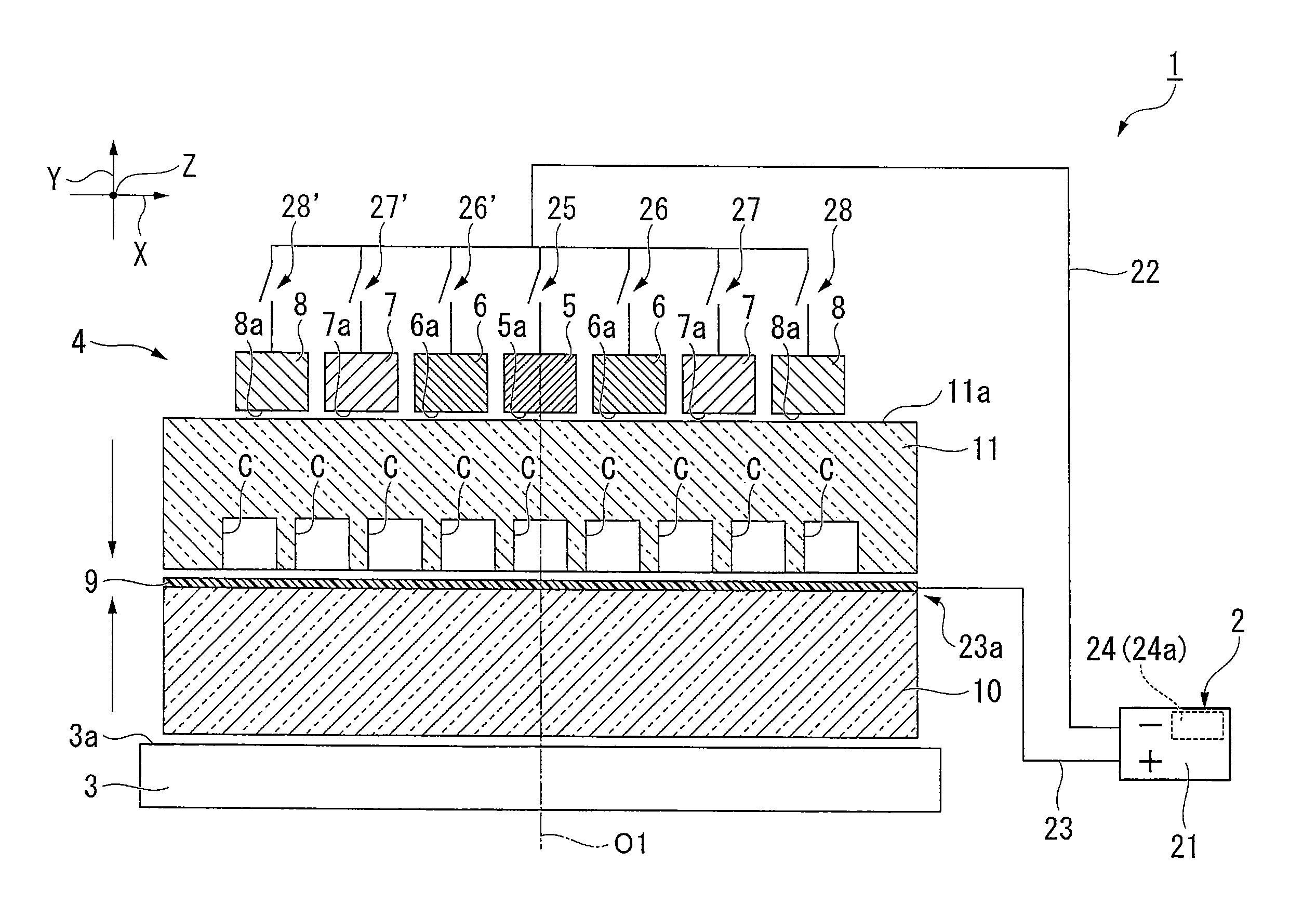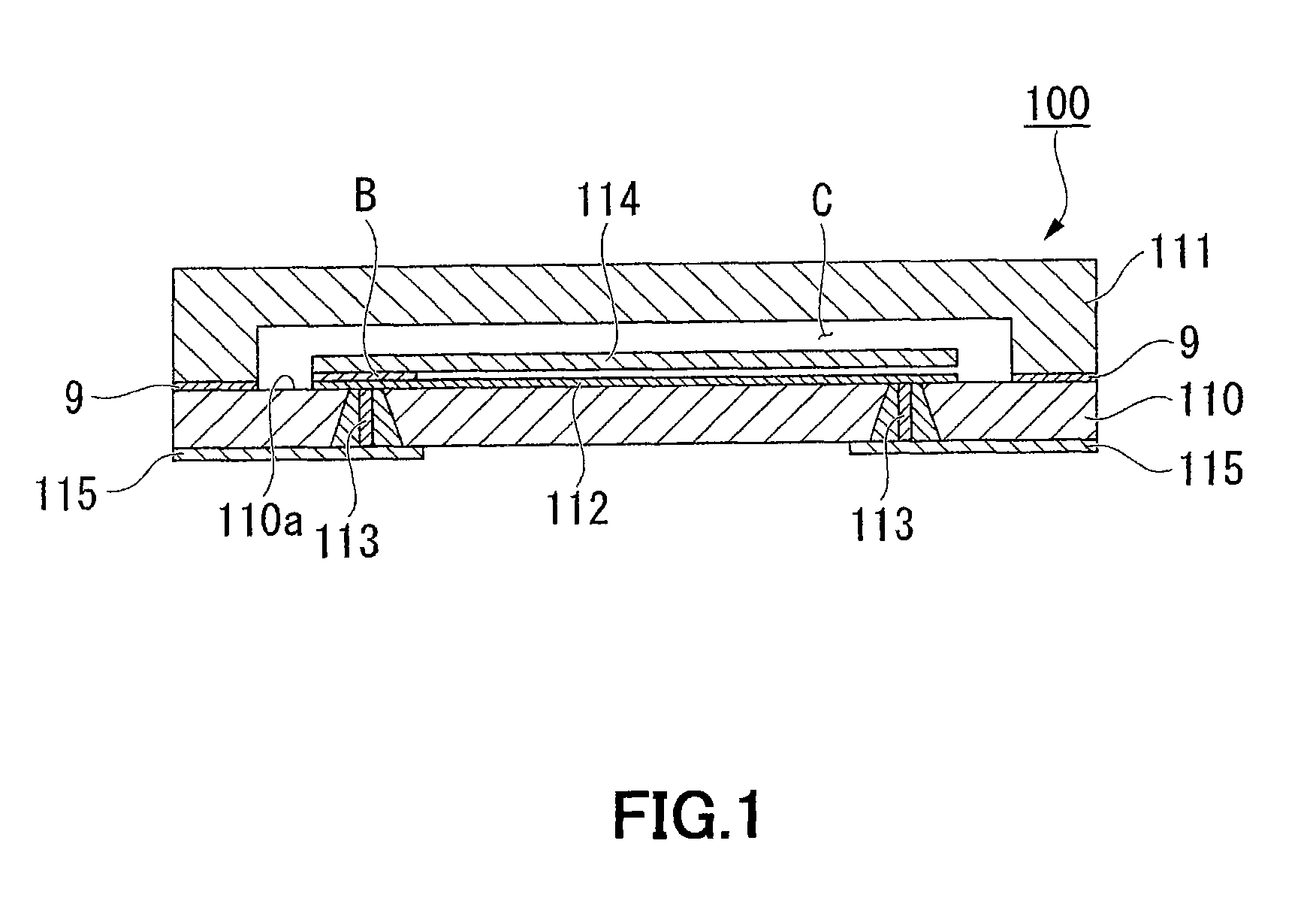Anodic bonding method and piezoelectric vibrator manufacturing method
a piezoelectric vibrator and manufacturing method technology, applied in the direction of electrical equipment, chemistry apparatus and processes, lamination ancillary operations, etc., can solve the problems of air trapped, voids formed in non-bonded areas, excessive voltage application, etc., to suppress the excess application of dc voltage at the central side of the concentric intended bonding area, improve the productivity of the piezoelectric vibrator, and suppress the uneven quality of the bonding surface
- Summary
- Abstract
- Description
- Claims
- Application Information
AI Technical Summary
Benefits of technology
Problems solved by technology
Method used
Image
Examples
first modification
[0101]Another configuration of a base wafer applicable to the above-described anodic bonding method will be described.
[0102]FIG. 8 is a sectional view showing the configuration of a base wafer and a lid wafer which can be applied to the anodic bonding method according to the above-described embodiment.
[0103]As shown in FIG. 8, in this modification, a base wafer 10a is used in place of the base wafer 10. The base wafer 10a has second cavities C2 which are disposed at positions where they face the cavities C in a state where the base wafer 10a is superimposed onto the lid wafer 11 and which have an opening having the same shape and size as the opening of each of the cavities C of the lid wafer 11 so that the openings can be superimposed on the openings of the cavities C. When the base wafer 10a and the lid wafer 11 are superimposed in the superimposition step (step S31), the openings of the cavities C oppose the openings of the cavities C2, and the cavities C and C2 each form one isol...
second modification
[0105]A second modification of the above-described embodiment will be described.
[0106]FIG. 9 is a sectional view showing the configuration of a base substrate and a lid substrate which can be applied to the anodic bonding method according to the above-described embodiment. As shown in FIG. 9, in this modification, the anodic bonding machine 1 is provided with an anode electrode 30 having the function of an anode in place of the setting table 3. The anode electrode 30 has a setting surface 3a on which the base wafer 10 is set, similarly to the setting table 3, and which is made of a conductive material. In this modification, the bonding film 9 of the base wafer 10 is not used as the electrode of the anodic bonding.
[0107]In this modification, the positive terminal of the power supply 2 and the anode electrode 30 are connected by the anode-side wiring 23. In this way, positive ions of the lid wafer 11 are moved towards the cathode electrode 4 between the bonding film 9 and the lid wafe...
third modification
[0109]A third modification of the above-described embodiment will be described.
[0110]In this modification, the setting values of the lengths of the application times T1, T2, T3, and T4 in the above-described embodiment are different from the setting values.
[0111]First, as shown in FIG. 6, a DC voltage is applied to the central electrode 5 to form the bonding surface Q1 in the intended bonding area A1 which is the same as the above-described embodiment.
[0112]Subsequently, the intended bonding area A2 shown in FIG. 7A is anodically bonded by using the central electrode 5. In the related art, a method of bringing a needle-like electrode into contact with one point on a substrate to widen the bonding surface (for example, the bonding surface Q1) in a radial form (concentric form) from the one point is known. In this modification, it is possible to widen the bonding surface in the order of the bonding surfaces Q1 and Q2 by using the central electrode 5. That is, an application time T1′ d...
PUM
| Property | Measurement | Unit |
|---|---|---|
| temperature | aaaaa | aaaaa |
| pressing force | aaaaa | aaaaa |
| pressing force | aaaaa | aaaaa |
Abstract
Description
Claims
Application Information
 Login to View More
Login to View More - R&D
- Intellectual Property
- Life Sciences
- Materials
- Tech Scout
- Unparalleled Data Quality
- Higher Quality Content
- 60% Fewer Hallucinations
Browse by: Latest US Patents, China's latest patents, Technical Efficacy Thesaurus, Application Domain, Technology Topic, Popular Technical Reports.
© 2025 PatSnap. All rights reserved.Legal|Privacy policy|Modern Slavery Act Transparency Statement|Sitemap|About US| Contact US: help@patsnap.com



